Look out, here comes another PalmPilot type PDA. This one is made by Texas Instruments and is called the Avigo. This machine’s target user is the mobile professional who wants instant access to contact information, schedule details, and spreadsheet info.
The Avigo comes with 1 meg of flash memory (approx. 680K available for storage), 160×240 pixel backlit display, quick-fold PC-link, 2 AAA batteries, CR 2025 backup battery, spare stylus, Lotus Organizer 97, IntelliSync for Avigo and the Texas Instruments Avigo Manager. The system requirements are: 486 or higher IBM compatible PC, MS Win95, or NT 4.0, 8MB RAM, 49MB available hard disk space, CD-ROM drive, available serial port, and a VGA monitor.
When I first looked at the Avigo, I immediately thought that it looked like a miniature Newton MessagePad 110 or 120 (minus the buttons). The plastic case is almost the same color as the PalmPilot (don’t you wish some companies would be a little more creative?). The size is a little larger (length-wise) over the PalmPilot.
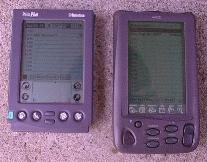

(PalmPilot / Avigo size comparison)
The Avigo has a nifty hinged screen cover that can flip all the way around and lay flat on the back of the unit (ala Newton MP2K). This is something that the PalmPilot really needs… The power switch doubles as the screen cover catch. When you power on the unit the cover pops open. On the back of the unit there is a reset switch, the battery compartment, and a memory door that reveals a socket that can accept upgrade memory modules. Also, it is important to note that the user can upgrade Avigo’s OS via the PC without having to take out the existing memory board and replacing it with a new one. The top of the Avigo has an infrared port and the bottom has the connector for the PC-Link
cradle. The case has a well made quality feel to it.



(front, back and open memory door views)
![]()
![]()
(infrared and pc-link connector views)
The 160×240 pixel touch screen is nice. The background isn’t quite as light colored as the PalmPilot. So I’d have to say that the Pilot’s screen is a bit crisper. The Avigo has a wheel on the left side of the display that can be used to adjust contrast. The backlight is terrific! It’s is very comparable to the Newton MP2000. It is bright and allows you to read the screen in dim light. For a comparison, see the picture below. This
is comparing the backlight of a PalmPilot, Avigo and Newton MP2000. I took this picture in a dim room with no flash.
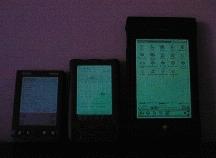
(backlight comparison between the Pilot, Avigo and MP2K)
The sensitivity of the touch screen is average. It responded reasonably well to my input, but I found that it sometimes would not recognize all of my strokes when using the Sketch application. This didn’t happen all the time, so it could be that I just have a light touch. The Avigo comes with a plastic stylus and a free spare. It’s nicer than the stock stylus that comes with the PalmPilot. It has just a little more ‘heft’ to it. I did find it a little difficult to remove the stylus from its holder quickly… I’m sure that it might loosen up with use.
The PC-Link is the device that connects to the PC’s serial port and the Avigo. It is a plastic docking station with a 9pin serial connector at one end. The great thing about it is that it can fold for better portability. It’s made well like the Avigo itself. Inserting the Avigo isn’t quite as easy as inserting the PalmPilot into its cradle… With the Avigo there are little grooves that you have to line up with the tracks on the base of the PC-Link. You also must hold on to the base to remove the Avigo from the PC-Link. Here are some pictures:
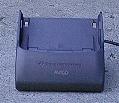
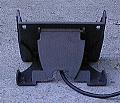
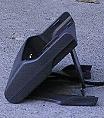

(front, back, side and inside PC-Link views)
The last feature hardware-wise that I want to talk about is the alarm (speaker). The alarm can be set to alert you when you have a meeting or event. The only user options that you have are to turn the alarm on or off. There isn’t a way to change the volume or sound that is played. If there are any PalmPilot users out there reading this review, you will probably agree that the speaker in the Pilot is very weak… it just isn’t loud enough. Well, the Avigo’s speaker makes the PalmPilot sound like a foghorn in comparison! In order to hear the Avigo’s alarm, you would need to either have it in your pocket or in extreme close proximity to your person. Here is a little example: I took the Avigo with me to a friends house. I set the alarm and put the Avigo on the kitchen counter. I was standing in front of it maybe one foot away. Two of my friends were standing one foot in front of me discussing a program that we were all working on. They were talking in normal tones. I heard the alarm on the Avigo go off. I let it continue ringing to see if my friends would hear it. After 15 seconds I called their attention to it. Only then did they hear it. I then put my friend’s Pilot on the counter in the same spot and sounded its alarm. It was noticeably louder. So, the bottom line here is that if you are going to depend on the Avigo to alert you to important meetings, you will need to be within VERY close reach of it at all times.
Now let’s discuss the real meat of the product, the built in applications. The Avigo comes with 3 different calculators that are pre-installed. A standard calculator, a cost-sell-margin calculator and a date calculator. There is also a separate financial calculator that you may install from the CD-ROM. I will talk about each in order. First, the standard calculator is just that. It has a square root function, percentage and one memory. A maximum of 12 digits can be displayed. The stylus is used to tap out the calculations. The cost-sell-margin calculator will let you
solve for any of the three values as long as you have the value for two of those variables. It’s designed to assist you in making informed decisions concerning cost, selling price, and profit margin. The date calculator will let you solve for either Start date, Number of Days or End date as long as you have one of these values. The most powerful calculator is the Financial TVM calculator that you can install from the CD-ROM. It has templates with built in formulas that solve problems like: computing amortization schedules, computing future values on savings acct. earnings, and retirement savings. The user guide has several really good examples on using this calculator.
The Avigo can use two methods of input. A standard popup keyboard is available, or a T9 keyboard can be used. The standard keyboard is a popup window that allows you to use the stylus to tap out each letter in a word. It contains all the letters, symbols, accents and punctuation symbols that you will need. The T9 keyboard is a text input system that has been developed by Tegic Communications. It looks like a touch-tone phone pad (see picture below). You use the stylus to tap the box that contains the letter you want. The T9 keyboard ‘senses’ what word you are trying to type. It most cases it guesses correctly, but in cases where more than one word is possible, you are given a list to select from. The T9 system has a large dictionary and the ability to add about 2000 words to a custom dictionary. When the custom dictionary is
full, the Avigo deletes infrequently used words to make space. Using either the standard or T9 keyboards, there are options to CUT and PASTE. Both keyboards will get the job done. If I had to choose, I would use the T9 keyboard but I personally didn’t care for either keyboard option. I prefer Graffiti like the PalmPilot or handwriting recognition like the Newton MessagePads. I let my friend who owns a PalmPilot but doesn’t use Graffiti try out the Avigo and T9 keyboard. He really liked it. So, I think that it is just a matter of personal preference.
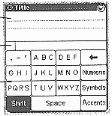
T9 Keyboard
The Calendar application: You can view the calendar in either one month or 6 month views. When in the one month view the current date is highlighted and scheduled events appear as dots under the date. In the 6 month view the current date is highlighted. What I didn’t like about the 6 month view was that it was just a display. You could not tap on a day and jump to it to schedule an event. You have to do all your scheduling in the one month view. In that view you can double tap on a date to see if anything is scheduled on that day, tap on the Schedule button to setup an event, or tap on the To Do button to check your list of things to do. In the Schedule view you can rotate the screen so that it will display a timeline graph and then the list of meetings below it. In this view, you can only look at the data, you can’t tap on an item to edit it. There is a weekly timeline view also…and again this is just for display. I didn’t like the fact that I could not interact with some of the screens. All in all, the calendar application will get the job done. I did notice that when I scheduled 2 meetings that overlapped, I wasn’t warned about it.
The Address application: This is the standard contact information app. It will let you set up to 8 categories to list people by. For example, you can setup a list of friends, doctors, etc. For each contact, you can set up home and work addresses, phone, pager, cellular, and fax numbers, email addresses, birthdate, and up to 8 misc. custom fields. If you set a birthdate for someone, it will show up in the calendar application.
There is an abilty to tap on a phone number in the index view and see all other numbers for that person in a window without having to go to a detail view of that entry. There is a search function and a quick lookup rolodex type bar at the bottom of the screen. I really liked this application.
The Data application: This application will let you create up to 8 data tables with up to 32 fields in each. You can transfer data to and from Microsoft Excel or Lotus 1-2-3 spreadsheets on your PC. It’s easy to transfer tables to and from the Avigo and the PC with the Avigo Manager software. The Data function also provides the user with the ability to create a data table and gather info on the handheld, and then zap it to the PC. This application is NOT a spreadsheet, and you can not do calculations on the rows and columns. It is just for displaying information. The screen can be rotated to see more columns, but like most of the other rotated modes, you can not tap on an entry to edit it. The rotated mode is just for display. For some reason (this could be a bug in the pre-production unit that I had), I couldn’t use the up/down rocker button to page up and down through my table in the rotated mode. The data application is useful, but I didn’t like the fact that you are limited to only 8 tables.
The Memo application: This application is like a notepad. You can create up to 8 different categories of memos, such as Business, Family etc. You can also add up to 4 custom fields to the memos. The screen can be rotated to read easier…and again I couldn’t use the up/down rocker button to scroll through a long memo. Instead I had to tap the arrow buttons with the stylus. A neat way to use this application is to create a memo in Lotus Organizer’s Notepad tool and then sync it to the Avigo. You could then carry a book or article with you to read when you are away from your desk.
The Expense application: This application will let you record, categorize, compute, and report expenses. You can assign up to eight categories to your expenses and have up to 8 different custom fields. The application will also let you create summaries of expenditures that have accrued during specific periods of time. You can also summarize the expenses by category or method of payment. This is a very nice application.
The Sketch application: This applications will let you draw simple pictures. A line, rectangle, circle, freehand tool, and eraser are included along with a stamp tool. The stamp tool will let you pick from 18 different clipart type stamps like a star, car, arrows etc. I wish they would have included a way to add text to a picture… This app. is pretty simplistic, but it does the job.
PC Syncing: The Avigo comes with 3 programs on the CD-ROM. Lotus Organizer, Intellisync for Avigo and the Avigo Manager. Lotus Organizer is a really nice PIM (Personal Information Manager). All address, scheduling information, to do lists, and memos can be synced to your Avigo using the Intellisync program. I really like this PIM and find it full featured and easy to use. Intellisync is the program that you run to sync your Avigo and Lotus Organizer. It’s also an easy to use program. The Avigo Program Manager is a separate program that you can use to upload new applications to your PDA. Right now, the only one available is the Financial calculator. If TI decides to release an SDK
(Software Development Kit), that might change. The Manager program also allows you to upload different languages to the Avigo. The available languages are English, French, German, Italian, and Spanish. Other options in the Avigo Manager program are the ability to backup, restore, update, import/export data tables, and import expense info. This suite of 3 programs work well together and might be the best set of tools packaged with a PDA so far.
Other misc. tools:
Memory Optimization Tool: A tool that lets you set up a time to automatically optimize the Avigo’s memory. This can be either manually, daily or weekly.
World Time Tool: A tool that will show you the current time in 5 different cities worldwide. Daylight savings time is calculated automatically.
Security Tool: A power on password can be set for the Avigo so that each time the unit is turned on, a password must be entered.
Review summary: Overall, I find that the Avigo is a well built unit that does its intended job well. If you are looking for your first PDA and don’t need options other than an address book, expense tracking, scheduling, and financial calculators, this might be the PDA for you. If you are looking for a replacement to your PalmPilot, you’re looking in the wrong direction.
Price: $299
Construction: B+
Screen Readability: B+
Audio/Speaker Support: C-
Built in Applications: B
Upgradibility (software/hardware): C
Battery Life: B+
Overall Rating: B+
I posed some questions to Bob Pospick (Avigo Product Manager). Here are the answers:
Q: How did the name Avigo come about?
A: Avigo is a compound word based on Latin and English roots: “avi” for lightweight (like birds) and “go” for people on the move (mobile professionals).
Q: Can you give me a couple of sentences concerning the availability of the SDK?
A: We do have an SDK which is currently used for internal program and application development. Distribution of this SDK is currently being
evaluated.
Q: Are there any plans to have a modem or to have email and other internet type capabilities?
A: TI strives to deliver products that effectively satisfy our target customers’ needs. We are currently evaluating these and other technologies, features and applications as they apply to the Avigo organizer.
Q: What processor does the Avigo use?
A: Avigo uses a custom Z-80 processor.
Google Review Tap Cards (3-Pack) by TapFive - Tap for Instant Reviews - All Phones Compatible - Reusable Smart Tap NFC & QR - Boost Business Reviews - Powered by TapFive (3 Card Pack)
$34.90 (as of December 4, 2025 03:58 GMT -05:00 - More infoProduct prices and availability are accurate as of the date/time indicated and are subject to change. Any price and availability information displayed on [relevant Amazon Site(s), as applicable] at the time of purchase will apply to the purchase of this product.)REVLIXI Google Review Stand -Boost Reviews w/Reusable Google Review Tap Card Stand & QR Code Stand- No App or Subscription - Android & iPhone Compatible-Boost Google Reviews for Online Growth
$24.89 (as of December 4, 2025 14:57 GMT -05:00 - More infoProduct prices and availability are accurate as of the date/time indicated and are subject to change. Any price and availability information displayed on [relevant Amazon Site(s), as applicable] at the time of purchase will apply to the purchase of this product.)Product Information
| Price: | $299.00 |
| Manufacturer: | Texas Instruments |


